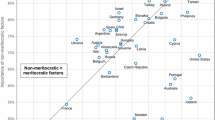Abstract
Any educational service is provided through a large number of separated institutions and many decisions are necessarily taken by individual schools, and, indeed, by individual teachers. However, these day-to-day decisions are taken within a framework laid down elsewhere. Power and responsibility in an educational system relate chiefly to the extent and nature of the resources provided, the curriculum and teaching methods, the character and purpose of individual institutions and the internal organization of those institutions. Significant decisions may be taken at national, state, local authority and individual school levels. Cutting across such patterns are employer-employee relationships and agreements negotiated with trade unions. The system of governance and administration of schools in England is seen as “a triangle of tension”, the three points being central government, local government and individual schools. Reference is made to patterns of curriculum, examinations, supervision and finance, the English approach being compared with practices elsewhere. It is argued that within the constraints imposed by the controlling authority individual schools shouls possess a great deal of flexibility in making their own decisions, including questions of student-staff ratios, allocation of teachers and expenditure of finance. Power and responsibility should not be divorced, but related; this is the logical development of a system of distributed administration.
Résumé
Tout service d'éducation est doté d'un grand nombre d'institutions distinctes, et, de ce fait, de nombreuses décisions sont prises individuellement par chacune des écoles, aussi bien que par chacun des enseignants. Quoiqu'il en soit, ces décisions prises au jour le jour, le sont dans les limites d'un cadre venant d'ailleurs. Dans un système d'éducation, pouvoir et responsabilité sont surtout liés à l'étendue et à la nature des ressources disponibles, du programme et des méthodes d'enseignement, du caractère et des objectifs de chaque institution, ainsi que de l'organisation interne de ces institutions. Les décisions importantes puevent être prises au niveau des autorités nationales, régionales ou locales, aussi bien qu'à celui de chacun des établissements scolaires. Les relations employeurs-employés, de même que les accords négociés avec les syndicats sont taillés sur le même modèle. En Angleterre, le système de gestion et d'administration des écoles apparait comme un triangle de tension dont les trois sommets sont constitués par le gouvernement central, le gouvernement local et les établissements scolaires eux-mêmes. Il est fait référence à d'autres modèles de programmes, d'examens, de contrôle et de finances, le système anglais étant comparé à ce qui ce fait ailleurs. Il est exposé que dans le cadre des contraintes imposées par l'autorité de contrôle, chaque école devrait posséder une grande marge de flexibilité pour prendre ses propres décisions, comprenant les questions des rapports d'associations d'élèves, les affectations des enseignants et les dépenses financières. Pouvoir et responsabilité ne devraient pas être séparés mais associés, tel est l'évolution logique d'une administration scolaire fonctionnant suivant un système de répartition.
Zusammenfassung
Jedes Bildungssystem besteht aus einer grossen Zahl separater Institutionen, und viele Entscheidungen müssen von den einzelnen Schulen und sogar den einzelnen Lehrern selbst getroffen werden. Der Rahmen für diese täglich notwendigen Entscheidungen wird jedoch an anderer Stelle festgelegt. Entscheidungsbefugnis und Verantwortung in einem Bildungssystem beziehen sich in der Hauptsache auf den Umfang und die Art der verfügbaren Mittel, auf Curricula und Lehrmethoden, den Charakter und Zweck der einzelnen Institutionen und ihre interne Organisation. Wichtige Entscheidungen können auf Staats-, Landes-, Bezirks- und Einzelschul-Ebene gefällt werden. Über diesen gazen Aufbau hinweg gehen Arbeitgeber-Arbeitnehmer-Beziehungen und Vereinbarungen mit Gewerkschaften. Das Leitungsund Verwaltungssystem für Schulen in England wird als ein “Spannungsdreieck” dargestellt, dessen drei Ecken die Zentralregierung, die örtlichen Behörden und die Schulen selbst bilden. Verschiedene englische Muster von Lehrplänen, Examen, Aufsich und Finanzen werden aufgezeigt und mit denen anderer Länder verglichen. Dabei wird betont, dass die einzelnen Schulen innerhalb der von der zuständigen Behörde gesetzten Grenzen ein grosses Mass von Entscheidungsfreiheit besitzen sollten, auch in Fragen wie Klassenstärke, Einsatz von Lehrern und Verwendung der Finanzmittel. Machtbefugnis und Verantwortung sollten nicht getrennt, sondern miteinander verbunden sein. Das ist die logische Entwicklung eines Systems aufgeteilter Verwaltung.
Similar content being viewed by others
Rights and permissions
About this article
Cite this article
Briault, E.W.H. A distributed system of educational administration: An international viewpoint. Int Rev Educ 22, 429–439 (1976). https://doi.org/10.1007/BF00598814
Issue Date:
DOI: https://doi.org/10.1007/BF00598814




